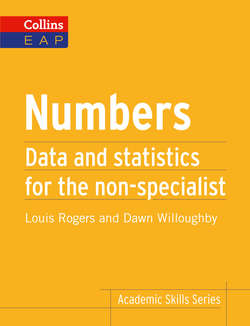Читать книгу Numbers: B2+ - Dawn Willoughby - Страница 11
Some terminology
ОглавлениеIn statistics, we use two key words: variable and observation. It is important to understand the difference in their meanings. A variable is a characteristic or an attribute that can have different values; an observation is the value of a variable that has actually been counted, measured or observed. Some variables are shown below, with a list of possible observations next to each one.
Glossary
variable A variable is a factor that can change in quality, quantity, or size, which you have to take into account in a situation.
characteristic The characteristics of a person or thing are the qualities or features that belong to them and make them recognizable.
attribute An attribute is a quality or feature that someone or something has.
| Variable | Observations |
| favourite colour | purple, blue, orange |
| number of pets | 3, 1, 0 |
| time spent reading | 2 hours, 1 hour |
| number of children in a family | 1, 5, 2 |
| eye colour | brown, blue |
| number of letters in a name | 10, 4, 8 |
The observations for a variable can be described as quantitative or qualitative, depending on what the information is about. Quantitative data is something which can be measured or counted using a number. Qualitative data represents a characteristic that uses words to describe it but does not use any numbers.
Examples of quantitative variables are:
time taken to complete a test
the number of books in a library
the highest temperature in a month
Examples of qualitative variables are:
the nationality of people in a cinema
the favourite sport of children in a school
the colours of balloons at a party
Exercise 6
Match the words on the left to their definitions on the right.
| 1 A variable | a Data which can be measured or counted using a number. |
| 2 An observation | b The value of a variable that has actually been counted, measured or observed. |
| 3 Quantitative | c Data representing a characteristic that uses words to describe it but does not use any numbers. |
| 4 Qualitative | d A characteristic or an attribute that can have different values. |
Exercise 7
State whether each of the following variables is quantitative or qualitative:
1 number of pages in a book
2 names of students in a class
3 hair colour
4 weight of apples in a bag
5 height of trees in a park
Exercise 8
Answer these questions.
1 Explain the difference between a quantitative and a qualitative variable.
2 Give an example of each type of variable.
3 Explain why:
‘type of tree’ is a qualitative variable
‘number of pupils in a class’ is a quantitative variable
Exercise 9
Without looking back at the section ‘What is statistics?’, put these statistical stages into the correct order.
1 organize data
2 present data
3 collect data
4 interpret data
Exercise 10
Use the words in the box to complete these questions about the stages above.
data features patterns sets of data
display method present technique
1 What type of ________are we interested in?
2 Which data collection ________shall we use?
3 What ________shall I use to summarize my data?
4 What interesting ________or ________can I see?
5 What questions do my ________answer?
6 What is the clearest way to ________and ________my data?
Exercise 11
Match the questions in Exercise 10 to the stages in Exercise 9.
